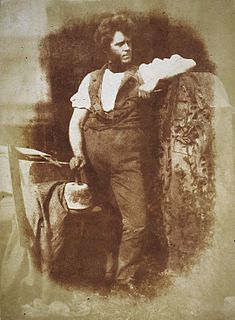Hugh Miller
| Hugh Miller | |
|---|---|

Hugh Miller, photographed by Hill & Adamson, circa 1843–1847.
|
|
| Born | 10 October 1802 Cromarty |
| Died | 23/24 December 1856 (age 54) Portobello, Edinburgh |
| Nationality | Scottish |
| Fields | geology |
Hugh Miller (10 October 1802 – 23/24 December 1856) was a self-taught Scottish geologist and writer, folklorist and an evangelical Christian.
Born in Cromarty, he was educated in a parish school where he reportedly showed a love of reading. At 17 he was apprenticed to a stonemason, and his work in quarries, together with walks along the local shoreline, led him to the study of geology. In 1829 he published a volume of poems, and soon afterwards became involved in political and religious controversies, first connected to the Reform Bill, and then with the division in the Church of Scotland which led to the Disruption of 1843.
In 1834 he became accountant in one of the local banks, and in the next year brought out his Scenes and Legends in the North of Scotland. In 1837 he married Lydia Mackenzie Falconer. In 1840 the popular party in the Church, with which he had been associated, started a newspaper, the Witness, and Miller was called to be editor in Edinburgh, a position which he retained till the end of his life.
Among his geological works are The Old Red Sandstone (1841), Footprints of the Creator (1850), The Testimony of the Rocks (1857), Sketch-book of Popular Geology. Of these books, perhaps The Old Red Sandstone was the best-known. The Old Red Sandstone is still a term used to collectively describe sedimentary rocks deposited as a result of the Caledonian orogeny in the late Silurian, Devonian and earliest part of the Carboniferous period.
Miller held that the Earth was of great age, and that it had been inhabited by many species which had come into being and gone extinct, and that these species were homologous; although he believed the succession of species showed progress over time, he did not believe that later species were descended from earlier ones. He denied the Epicurean theory that new species occasionally budded from the soil, and the Lamarckian theory of development of species, as lacking evidence. He argued that all this showed the direct action of a benevolent Creator, as attested in the Bible – the similarities of species are manifestations of types in the Divine Mind; he accepted the view of Thomas Chalmers that Genesis begins with an account of geological periods, and does not mean that each of them is a day; Noah's Flood was a limited subsidence of the Middle East. Geology, to Miller, offered a better version of the argument from design than William Paley could provide, and answered the objections of sceptics, by showing that living species did not arise by chance or by impersonal law.
...
Wikipedia
